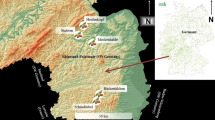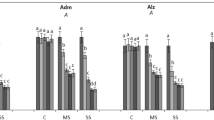Abstract
Argania spinosa (the argan tree) is a slow-growing tree endemic of Morocco, growing on semi-arid areas where no other tree species can live. With the aim of predicting temporal changes in A. spinosa woodlands under a probable increase in aridity, we set off to investigate these questions: how do A. spinosa physiological attributes respond to variations in climatic conditions and seasonality, and which is the set of attributes that most affects tree response to environmental conditions? In three study sites, Beni Snassen (North), High-Atlas (Mountain) and Admine Forest in Agadir (Coastal), gas exchange measurements, photochemical efficiency, leaf water potential and different leaf attributes were monitored in February, July and November of 2006. The Mountain site presents the most continental climate. Trees in this site were the most stressed in summer, having the lowest midday leaf water potential values, photochemical efficiency and assimilation rates. We found a Ψmd threshold around -4 MPa, below which stomatal conductance responds linearly to Ψmd. Plants from the North area never reached this threshold during the study period. Although leaf pigments presented a clear seasonal pattern, leaves from Coastal trees exhibit the highest content for each season. The three study sites were separated by two discriminate functions obtained by canonical discriminant analysis. In summer, the Mountain population is separated from the other sites mainly by assimilation rate and Fv/Fm, while in winter transpiration rates and chlorophyll content are the main discriminant variables. Our study shows that A. spinosa trees adjust their physiological status and leaf attributes to environmental conditions allowing plants to thrive under a dry climate. Under a scenario of global change, the distribution of the argan tree likely shifts to milder areas.







Similar content being viewed by others
Abbreviations
- A:
-
CO2 assimilation rate
- gs :
-
Stomatal conductance
- E:
-
Evapotranspiration rate
- PPFD:
-
Photosynthetic photon flux density
- Fv/Fm :
-
Maximal PSII quantum yield
- ΦPSII :
-
Effective PSII quantum yield
- RWC:
-
Relative water content
- LDMC:
-
Leaf dry matter content
- LMA:
-
Leaf mass area
- PET:
-
Potential evapotranspiration
- VPD:
-
Vapour pressure deficit
- CDA:
-
Canonical discriminant analysis
- Ψmd :
-
Midday leaf water potential
References
Alados CL, El Aich A (2008) Stress assessment of argan (Argania spinosa L. Skeels) in response to land use across an aridity gradient: translational asymmetry and branch fractal dimension. J Arid Environ 72:338–349
Ain-Lhout F, Zunzunegui M, Tirado R, Clavijo A, Díaz-Barradas MC, García Novo F (2001) Comparison of proline accumulation in two Mediterranean scrubs subject to natural and experimental water deficit. Plant Soil 230:175–183
Bates LS, Waldren RP, Teare ID (1973) Rapid determination of free proline for water stress studies. Plant Soil 39:205–207
Benabid A (1982) Bref aperçu sur la zonation altitudinale de la végétation climacique du Maroc. Ecol Med VIII(1–2):301–315
Bilger W, Schreiber U, Bock M (1995) Determination of the quantum efficiency of photosystem II and of non-photochemical quenching of chlorophyll fluorescence in the field. Oecologia 102:425–432
Bucci SJ, Goldstein G, Meinzer FC, Franco AC, Campanello P, Scholz FG (2005) Mechanisms contributing to seasonal homeostasis of minimum leaf water potential and predawn disequilibrium between soil and plant water potential in neotropical savanna trees. Trees 19:296–304
Charrouf Z, Guillaume D (1998) Ethnoeconomical, ethnomedical and phytochemical study of Argania spinosa (L.) Skeels: a review. J Ethno farm 67:7–14
Charrouf Z, Guillaume D (2002) Secondary metabolites from Argania spinosa (L.) Skeels. Phytoch Rev 1:345–354
Choat B, Ball MC, Luly JG, Holtum JAM (2005) Hydraulic architecture of deciduous and evergreen dry rainforest tree species from north-eastern Australia. Trees 19:305–311
Collier A, Lemaire B (1974) Etude des caroténoïdes de l'huile d'argan. Cah Nutr Diét 9:300–301
Connor DJ (2005) Adaptation of olive (Olea europaea L.) to water-limited environments. Aust J Agr Res 56:1181–1189
Correia O, Díaz-Barradas MC (2000) Ecophysiological differences between male and female plants of Pistacia lentiscus L. Plant Ecol 149:131–142
Díaz-Espejo A, Walcroft AS, Fernandez JE, Hafidi B, Palomo MJ, Giron IF (2006) Modelling photosynthesis in olive leaves under drought conditions. Tree Physiol 26:1445–1456
Díaz-Espejo A, Nicolás E, Fernández JE (2007) Seasonal evolution of diffusional limitations and photosynthetic capacity in olive under drought. Plant Cell Environ 30:922–933
Dindane K, Bouchaou L, Hsissou Y, Krimissa M (2003) Hydrochemical and isotopic characteristics of groundwater in the Souss Upstream Basin, southwestern Morocco. J Afr Earth Sci 36:315–327
El Aboudi A (1990) Typologie des Arganeraies Inframéditerranéenes et Écophysiologie de l’Arganier (Argania spinosa (L.) Skeels) dans le Souss (Maroc). Dissertation. Université Joseph Fourier, Grenoble, France
El Aich, El Assouli N, Fathi A, Monrad-Fehr P, Bourbouze A (2005) Ingestive behaviour of grazing goats in the southwestern argan forest of Morocco. Ref. RUMIN 1034
El Yousfi SM (1988) La dégradation forestière dans le sud marocain: exemple de l’arganeraie d’Admine (Souss) entre 1969 et 1986. Mémoire de 3ème cycle Agronomie. Institut Agronomique et Vétérinaire Hassan II. Rabat
Fernández JE, Diaz-Espejo A, D'Andria R, Sebastiani L, Tognetti R (2008) Potential and limitations of improving olive orchard design and management through modelling. Plant Biosyst 142:130–137
Garnier E, Shipley B, Roumet C, Laurent G (2001) A standardized protocol for the determination of specific leaf area and dry matter content. Funct Ecol 15:688–695
Genty B, Briantais JM, Baker NR (1989) The relationship between the quantum yield of photosynthetic electron transport and quenching of chlorophyll fluorescence. Bioch Bioph Acta 990:87–92
Gouveia AC, Freitas H (2008) Intraspecific competition and water use efficiency in Quercus suber: evidence of an optimum tree density? Trees 22:521–530
Hargreaves GH, Samani ZA (1985) Reference crop evapotranspiration from temperature. Applied Engrg Agric 1:96–99
Hsissou Y, Mudry J, Mania J, Bouchaou L, Chauve P (1997) Dynamique et salinité de la nappe côtière d’Agadir (Maroc), influence du biseau salé et des faciès évaporitiques. In: Hydrochemistry Proceedings of the Rabat Symposium. International Association of Hydrological Sciences (IAHS), pp. 73–82. IAHS, Publication No. 244
Jones HG (1983) Plants and microclimate. A quantitative approach to environmental plant physiology. Cambridge University Press, Cambridge
Kozlowski TT (2002) Physiological ecology of natural regeneration of harvested and disturbed forest stands: implications for forest management. For Ecol Manage 158:195–221
Lansac AR, Zaballos JP, Martín A (1994) Seasonal water potential changes and proline accumulation in Mediterranean shrubland species. Vegetatio 113:141–154
Larcher W (1995) Physiological plant ecology. Springer, New York
Levitt J (1980) Responses of plants to environmental stresses. Academic, New York
Lichtenthaler HK (1987) Chlorophylls and carotenoids: pigments of photosynthetic biomembranes. Meth Enzymol 148:350–382
Mediavilla S, Escudero A (2003) Stomatal responses to drought at a Mediterranean site: a comparative study of co-occurring woody species differing in leaf longevity. Tree Physiol 14:987–996
M’Hirit O, Benzyane M, Benchekroum F, El Yousfi SM, Bendaanoun M (1998) L’arganier: une espèce forestière à usages multiples. Mardaga, Belgique
Munné-Bosch S, Alegre L (2000) Changes in carotenoids, tocopherols and diterpenes during drought and recovery, and the biological significance of chlorophyll loss in Rosmarinus officinalis plants. Planta 210:925–931
Niinemets Ü, Cescatti A, Rodeguiero M, Tosens T (2006) Complex adjustments of photosynthetic potentials and internal diffusion conductance to current and previous light availabilities and leaf age in Mediterranean evergreen species Quercus ilex. Plant Cell Environ 29:1159–1178
Peltier JP, Carlier G, Elaboudi A (1990) Daily water-uptake of argan tree leaves, Argania spinosa (L) skeels, in an arid bioclimate with strong oceanic influence (Souss plains, Morocco). Acta Oecol 11:643–668
Peñuelas J, Gordon C, Llorens L, Nielsen T, Tietema A, Beier C, Bruna P, Emmett B, Estiarte M, Gorissen A (2004) Nonintrusive field experiments show different plant responses to warming and drought among sites, seasons and species in a North-South European gradient. Ecosystems 7:598–612
Reda Tazi MR, Berrichi A, Haloui B (2003) Ésquisse cartographique de l’aire de l’arganier Argania spinosa (L.) Skeels au Maroc nord-oriental. Bulletin de l’Institut scientifique. Rabat. Section Science de la Vie 25:53–55
Saura-Mas S, Lloret F (2007) Leaf and shoot water content and leaf dry matter content of Mediterranean woody species with different post-fire regenerative strategies. Ann Bot 99:545–554
Scarascia-Mugnozza G, Oswald H, Piussi P, Radoglou K (2000) Forests of the Mediterranean region: gaps in knowledge and research needs. For Ecol Manage 132:97–109
Scholander PF, Hammel HT, Bradstreet ED, Hemmingsen EA (1965) Sap pressure in vascular plants. Science 148:339–346
Schreiber U, Hormann H, Neubauer C, Klughammner C (1995) Assesment of photosystem II photochemical quantum yield by chlorophyll fluorescence quenching analysis. Aust J Plant Physiol 22:209–220
Tardieu F, Simonneau T (1998) Variability among species of stomatal control under fluctuating soil water status and evaporative demand: modeling isohydric and anisohydric behaviours. J Exp Bot 49:419–432
Tenhunen JD, Beyschlag W, Lange OL, Harley PC (1987) Changes during summer drought in leaf CO2 uptake rates of macchia shrubs growing in Portugal: Limitations due to photosynthetic capacity, carboxylation, efficiency, and stomatal conductance. In: Tenhunen JD, Catarino FM, Lange OL, Oechel WC (eds) Plant response to stress, NATO ASI Series Vol. G15. Springer, Heidelberg, pp 305–327
Werner C, Ryel RJ, Correia O, Beyschlag W (2001) Effects of photoinhibition on whole-plant carbon gain assessed with a photosynthesis model. Plant Cell Environ 24:27–40
Zunzunegui M, Díaz Barradas MC, García Novo F (2000) Different phenotypic response of Halimium halimifolium in relation to groundwater availability. Plant Ecol 148:165–174
Zunzunegui M, Díaz-Barradas MC, Ain-Lhout F, Clavijo A, García Novo F (2005) To live or to survive in Doñana dunes: Adaptive responses of woody species under a Mediterranean climate. Plant Soil 273:77–89
Zunzunegui M, Ain-Lhout F, Jáuregui J, Díaz-Barradas MC, Boutaleb S, Álvarez-Cansino L, Esquivias MP (2010) Fruit production under different environmental and management conditions of argan, Argania spinosa (L.). J Arid Env. doi:10.1016/j.jaridenv.2010.03.016
Acknowledgement
This research was supported by a project from the Spanish Agence of International Cooperation (AECI).
Author information
Authors and Affiliations
Corresponding author
Additional information
Responsible Editor: John McPherson Cheeseman.
Rights and permissions
About this article
Cite this article
Díaz-Barradas, M.C., Zunzunegui, M., Ain-Lhout, F. et al. Seasonal physiological responses of Argania spinosa tree from Mediterranean to semi-arid climate. Plant Soil 337, 217–231 (2010). https://doi.org/10.1007/s11104-010-0518-8
Received:
Accepted:
Published:
Issue Date:
DOI: https://doi.org/10.1007/s11104-010-0518-8




